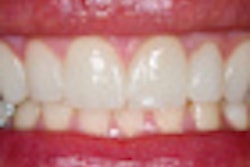
Patients who come in for cosmetic work are often seeking the perfect smile. But some dentists are compromising sound enamel and dentin to give patients unnecessary porcelain crowns and veneers, according to Martin Kelleher, BDS, MSc, a consultant in restorative dentistry at the King's College London Dental Institute.
In an editorial published this summer in Faculty Dental Journal (July 2011, Vol. 2:3, pp. 134-141), Dr. Kelleher discussed the dangers of aggressive, expensive, and at times unnecessary treatment of minor cosmetic problems with brittle porcelain.
In fact, Dr. Kelleher has coined a new term for this phenomenon: "porcelain pornography."
It is increasingly common to see patients who have received restorative treatment that was probably of more benefit to the profits of the dentists than to the patients' long-term dental health, he stated in the editorial.
"In my view, many of these unfortunate patients are being robbed twice -- first of their money and again of their (even more precious) sound tooth structure," he wrote. "I call this 'double mugging.' "
According to Dr. Kelleher, the overuse of porcelain crowns and veneers originated in the U.S. to produce the "very even, very white look" Hollywood look, and various factors may have contributed to the growth of this trend.
Some possible reasons could be patient demand from a largely superficial and image-obsessed society, Dr. Kelleher told DrBicuspid.com. "Payment systems, a fix-it culture, money, or speed could also be factors in some specific circumstances," he said.
Structural damage
Unnecessary porcelain crowns and veneers mean substantial structural damage of teeth -- up to 30% of sound load-bearing tooth can be removed for extended ceramic veneers and about 62% or more for all ceramic crowns, Dr. Kelleher claimed.
"Some 18% of pulps die when full-coverage ceramic-based crowns are used, and 50% of porcelain veneers are either no longer present or satisfactory after 10 years," he said.
“I would call the unnecessary use of crowns and veneers malpractice.”
— Ronald Goldstein, DDS
Most dentists inform their patients about these negative aspects but many do not because of financial and other concerns, Dr. Kelleher noted. The good dentist should lean toward treatments that preserve the long-term dental health of the patient, and inform the patient of all available treatments and also their consequences.
Porcelain veneers and crowns have their place in responsible restorative dentistry, but most cosmetic problems could be resolved with more conservative procedures, Dr. Kelleher said.
"Alignment of teeth or bleaching and direct composite will solve most problems at a minimal biologic cost," he noted.
Ronald Goldstein, DDS, one of the founders and past president of the American Academy of Esthetic Dentistry and author of Change Your Smile, confirmed that a culture of fitting patients with unnecessary porcelain crowns and veneers exists in the U.S.
"Dentists have embraced porcelain veneers more than any other dental technique in recent times," he told DrBicuspid.com. "The procedure has been overused for several years now, especially in situations such as end-to-end occlusion and other bite problems."
Not every patient will experience problems with porcelain veneers and crowns, and in many cases, their use is indicated.
"But too many times it's really the treatment of choice for the dentist instead of the patient," Dr. Goldstein said.
Many times a direct bonded restoration might work better than veneers or crowns, but it's more about how a dentist values ethics and the need of the patient rather than the need of the practice, he added.
"I would call the unnecessary use of crowns and veneers malpractice," Dr. Goldstein said.
More conservative alternatives
Full crowns and fixed bridges or implants followed by full crowns are prosthodontic alternatives in some cases, such as when a patient has a total breakdown of teeth, missing teeth, or extensive bone loss, according to Dr. Goldstein.
In addition, porcelain veneers are indicated when the teeth need building out so that little or no enamel is removed, or when it is feasible to save more tooth structure rather than reducing teeth for full crowns, he said.
While a conservative alternative is often an option, not enough dentists consider it, according to Dr. Goldstein.
"Porcelain veneers are expensive and have a limited life expectancy," he said. "It is the dentist's responsibility to let the patient know about cheaper and conservative options, such as direct composite resin bonding."
Dentists can create a perfect smile by using orthodontics, bleaching, and cosmetic contouring, according to Dr. Goldstein. It is important to present patients with all treatment options, provide their advantages and disadvantages, and obtain informed consent.
However, sometimes dentists are left with limited choices because the patient simply refuses conservative treatment such as orthodontics because they want the perfect smile in a hurry, he added. These requests can put a lot of pressure on the dentist.
"For example, sometimes a patient walks in and says, 'I have my high school reunion in one month, and I want perfect teeth by then,'" Dr. Goldstein said.



















